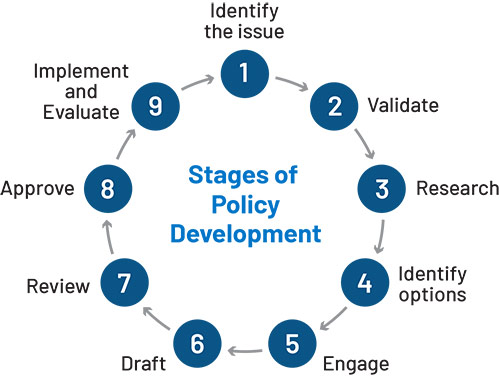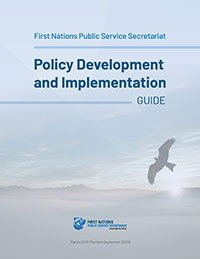Module 2: Creating Policy
Module 2 outlines the key steps in the policy development process. Having a clear and transparent process for policy development assists in creating trust and respect within the First Nation. The following topics are covered in Module 2:
- Policy development models – explaining the options based on the need
- Key steps for developing policy
- Leading consultation in community on policy development
- Staying on track with the policy process
- Practical checklist for developing a policy process
Policy development models – explaining the options based on the need
There are various options for policy development to achieve the intended purpose of the First Nation. Choosing an option depends on whether this is a new policy, revisions to an existing policy or reflects the need for the development of a policy over time. Below are the main examples of policy development approaches – rational, incremental, stage-sequential and policy stream.
First Nation Case Study - Upper Nicola Band
The Finance Policy that UNB developed, with the FMB's assistance, considers the following: Annual Planning and Budgeting, Financial and Operational Reporting, Financial Institution Account and Cash Management, Purchasing, Expenditures, Borrowing, Lending Guarantees and Indemnities, Investments, Capital Assets, Insurance Policies, Risk Management, Emergencies and Operations Continuity, and Financial Management System Improvement.
First Nation Case Study - Upper Nicola Band
UNB Housing Policies incorporate the following:
- UNB Rental Policy
- UNB Rent-to-Own Policy
- UNB Market Housing Policy
- UNB Private Homeowners Policy
When UNB began to update its Housing Policies in 2015, it was recognized that it would be beneficial to break down the Housing Policy into four individual policies to better understand each housing program provided by UNB.
'Cyclical' means that the process occurs with the same steps each time a policy is developed.
'Dynamic' means that the stages may not flow in one direction – some steps may need to be repeated and then the cycle continues.
First Nation Case Study - Upper Nicola Band
In 2014, UNB invested Band monies into an investment fund for the first time. Leaders developed and passed a policy in 2015 that provides the Finance Audit Committee (FAC) and the Chief and Council with a comprehensive set of guidelines surrounding the authorized uses and distribution of income and capital from the UNB Investment Accounts.
First Nation Case Study - Upper Nicola Band
In 2017 and 2018, UNB experienced floods, and an emergency was declared. When the Emergency Operation Centre was opened, policies to respond to the emergency were put in place. Although the work was guided by the Emergency Management Plan, the policies that developed were flexible and less formalized.
Key steps for developing policy
Policy development involves several basic steps and occurs on a cyclical basis. These steps occur regardless of approach. While steps in policy development are generally sequential, the steps may need to be repeated more than once in order to complete the cycle. In undertaking policy development, clarity in the identification of the issue to be addressed is a key factor in a sound policy development process. The following summarizes the key steps in the policy development process.
- Identify the issue: Work to identify or clarify an issue as a public or community concern, challenge or opportunity (the issue may be new or already known)
- Validate: Validate the nature of the issue through research, fact and evidence gathering
- Research: Research where other First Nations have developed policies addressing similar issues or concerns
- Identify options: Create a range of optional policy approaches to address the specific issue, along with pros and cons; a policy document is usually prepared to facilitate the decision-making process, and includes issue identification, a summary of the research and consultations, an impact analysis, policy options and a recommended course of action
- Engage: Consult and engage community members, Leaders, Administrators and other stakeholders
- Draft: Draft the policy. Once you start to draft the policy, begin with an approach that looks like it will work the best. As you begin to draft, you may determine that a different approach must be taken.
- Review: Review the draft policy for clarity and clear language
- Approve: Approve the policy
- Implement, communicate and evaluate: Implement the policy, create a communications strategy for the implementation and measure its success
Figure 1 illustrates the stages in a policy cycle. While the policy development stages are sequential in nature, there may be a need for a First Nation to repeat a stage before proceeding to the next phase. For example, options may be refined following engagement with the community and interested parties, or a draft policy may be revised several times during the review stage. The community may review the revised policy before it is approved.

Figure 1: Policy Cycle Stages
Leading consultation in community on policy development
Consultation and communications planning are essential in the policy development process. These processes help inform solutions and assist in building acceptance when the policy is put into practice. Consultation should occur early in the policy development process to ensure meaningful opportunity for input. These should be targeted and proactive to provide the opportunity for Leaders, Administrators, members, community organizations, service delivery groups, other governments and other stakeholders to contribute to the formation of options or to formulate responses to the proposed policy options.
First Nation Case Study - Upper Nicola Band
In 2017, when UNB began to develop its Finance Policy, the FMB assigned a consultant to work with UNB Administrators.
Step 1 – Identify the issue
A consultant appointed by FMB met with UNB Administrators (specifically, the Chief Financial Officer and the Band Administrator) and reviewed the FMB Finance Policy Template.
The Template is a sample finance policy which describes what is mandatory and optional and provides examples of best practices to meet the requirements of the UNB's Financial Administration Law to guide First Nations in creating their own finance policy.1
After reviewing the Template, it was clear that UNB did not have clear finance
practices that would: a) help Leaders and Administrators make informed decisions;
and b) allow the First Nation to run effectively.
Step 2 – Validate
By FMB providing a Sample Finance Policy, the nature of the issue was validated through research and fact / evidence gathering. UNB, like many First Nations historically, had all decisions made for them by the federal government; they realized they could set their own governance structures and policies as they related to financial management.
UNB's Senior Administrators reviewed the FMB Finance Policy Template sections and carried out an analysis of the existing UNB finance management systems in order to identify areas for internal improvement. In some instances, UNB carried out solid practices that were noted in the FMB Finance Policy Template; the Administrators just did not have their practices formally written into a policy document. For example, UNB had procedures to obtain sufficient insurance for its operations, Administrators and Leaders. However, these procedures were not written down, and it was noted that if there were staff changes, the procedures might not be known or followed. In other instances, UNB did not even consider having policies in place, including in the areas of multi-year budgeting, linking its budgets to the strategic plans, procurement and expenditure spending levels, long-term debt, investments, tangible capital assets, risk management and fiscal management system improvements.
Step 3 – Research
The FMB Finance Policy Template provided best practices. Senior Administrators identified similar issues that had occurred in other First Nations and were able to discern through discussions what had or had not worked in terms of policy responses. When looking at the Investment Policy, UNB learned the importance of ensuring that this policy linked with UNB's strategic priorities and that there were guidelines in place for expenditure of investment funds.
TIP: Look for sample templates and best practices in the First Nations in BC Knowledge Network's Resource Library located at fnbc.info/resources.
Step 4 – Identify options
In addition to the optional approaches within the FMB Finance Policy Template to identify options, the FMB Finance Policy Template provides a recommended course of action, with some best practices included.
Step 5 – Engage
Senior Administrators worked with UNB's Finance Audit Committee (FAC) to review the FMB Finance Policy Template. FAC members were asked to familiarize themselves with the FMB Finance Policy Template.
Step 6 – Draft
UNB Senior Administrators drafted the Finance Policy using the FMB Finance Policy Template.
Step 7 – Review
Senior Administrators brought the draft Finance Policy forward to the FAC for a review of language and clarity.
Step 8 – Approve
When the FAC was comfortable with the Finance Policy, it was brought forward to Leaders for approval. The Band Administrator presented the Policy. Leaders signed a Band Council Resolution (BCR), noting that they approved the Policy. The signed BCR was placed within the policy document, at the front, and it was saved in PDF format. (It is a good practice to include the signed BCR in PDF format in an appendix to the final policy document.)
Step 9 – Implement, communicate and evaluate
The signed Finance Policy was saved on the internal server and also emailed out to all UNB Leaders and Administrators. UNB as an organization began to implement the Policy. Training for Administrators was provided to ensure they received a copy of the Policy, and that they understood their responsibilities within the Policy. UNB membership was advised via the UNB newsletter and the annual report that the Policy was approved and UNB had commenced its implementation.
After two and a half years, UNB is feeling more comfortable with implementation of the Policy, and is beginning to see positive results, one of which has been the opportunity to become a recipient of the 10-Year Grant from Indigenous Services Canada.
Staying on track with the policy process
The review and evaluation of policies is important for maintaining a clear, open and effective policy development process.
Policy evaluation means checking the effects of policies and assessing the policies in terms of necessity, efficiency and validity to improve the planning and implementation processes.
There are several key steps in reviewing and assessing the effectiveness of a policy:
- Identify the key interests and leaders in developing a policy: This means identifying the department charged with implementing the policy and also the intended recipients of / those impacted by the policy.
- Describe the policy being assessed or evaluated: This includes: an overview of the policy, its goals and objectives; the department(s) responsible for its implementation or enforcement; and the activities undertaken.
- Collect the data needed for the assessment / evaluation: The data may be qualitative, quantitative or a combination of both.
- Analyze the data: Depending on the types of data collected and the nature of the evaluation, an evaluation of policies should include a review of quantitative and qualitative data.
- Report evaluation conclusions: This should include specific recommendations for policy changes or program improvements. The report should be shared with Administrators who have a role in developing and implementing the policy.
First Nation Case Study - Upper Nicola Band
UNB's Finance Department is primarily responsible for the administration of the majority of the Finance Policy, and other departments and all Administrators are responsible for implementing the whole of the Finance Policy. If UNB does not implement portions of the Finance Policy, then it is not implementing the FAL 2018. Repercussions could include members bringing forward concerns to Leaders and viewing Administrators as not accountable or transparent.
Practical checklist for developing a policy process
Checklists are designed to keep the policy development process moving forward in the intended direction and to address barriers along the way. The following is a sample checklist that can be adapted as needed.
- Identify how policy currently works or the need for a policy development process
- Consider the stages of effective policy development
- Review the principles you want to achieve
- Build or renew a desired policy development process based on the above
- Consider the resources and expertise required
- Brainstorm potential challenges of creating policy
- Engage on both government and community bases with your proposed policy development process
- Modify the policy development process based on feedback
- Document the policy development process and communicate within the First Nation / community – communicate and educate
- Follow the policy development process and review / evaluate at appropriate timing intervals

Community policy scenario – interactive questions
There are many key elements presented in Module 2 with respect to how policy is developed, how challenges are addressed throughout the process and how effective policy development is maintained. To assist you in learning about the concepts presented, think about a policy needed, or a time when you developed policy, and provide responses to the questions below.
Download the interactive questions (Microsoft Word)
| Policy Example | |
|---|---|
|
Topic / Subject:
|
Type of Policy:
|
| Policy Process | |
|
How would you describe the critical steps in developing the policy?
|
|
|
Describe if and how these steps changed during the policy development process.
|
|
| Policy Challenges | |
|
What are the challenges related to this policy?
|
|
|
Describe how the challenges were created by the policy triggers.
|
|
|
What steps were taken to address the challenges?
|
|
Footnote
[1] Visit fnfmb.com/en/tools-and-templates/finance to view the Sample Finance Policy
